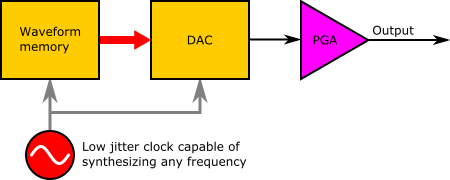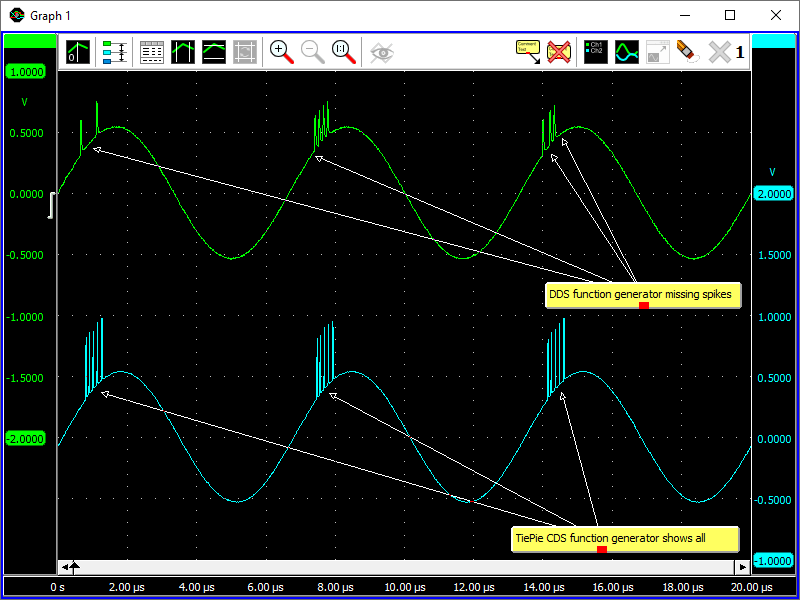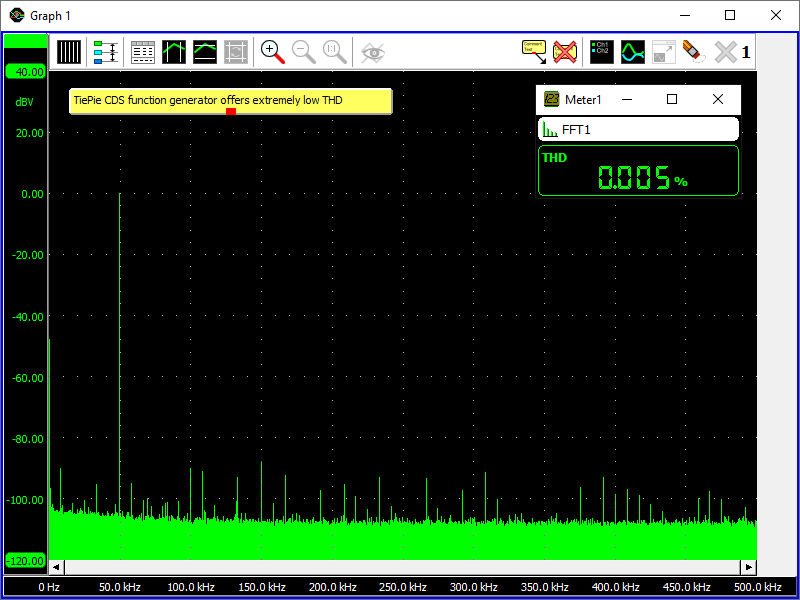TiePie WiFiScope WS5 and Handyscope HS5 arbitrary function generators offer the lowest THD in their class.
TiePie's exclusive Constant Data Size (CDS) technology enables generating true form (point-by-point) arbitrary waveforms with exceptionally low jitter and high fidelity. CDS has many advantages over its predecessor, the well known DDS system. CDS technology is applied to the WiFiScope WS5 and Handyscope HS5 Arbitrary Waveform Generator, making them function generators with great flexibility and unparalleled performance, at the price of a common DDS function generator. This article shows the exceptional qualities of CDS compared to DDS.
TiePie CDS explained

TiePie's CDS technology internally uses a low-jitter temperature compensated clock, capable of synthesizing any frequency, to linearly drive data from the waveform memory to a digital-to-analog converter (DAC) creating the analog signal. Because no memory values are skipped or repeated and each value is output for the same amount of time, the result is an optimal true form point-by-point arbitrary waveform.
Advantages of TiePie CDS compared to DDS
The CDS technology used in the WiFiScope WS5 and Handyscope HS5 Arbitrary waveform generator is superior to traditional Direct Digital Synthesis (DDS) which has been applied in the recent decades. DDS has many drawbacks, such as high jitter when generating low frequency signals and a high Total Harmonic Distortion (THD). CDS eliminates these drawbacks and gives every engineer access to an Arbitrary waveform generator with characteristics previously unaffordable.

To illustrate the difference between DDS and CDS, figure 2 shows the same arbitrary waveform generated by a DDS function generator (Handyscope HS3) and by a Handyscope HS5 CDS function generator. The arbitrary signal consists of a period of a sine wave with 5 spikes superimposed. While the DDS function generator (green line) misses spikes at random, the revolutionary CDS function generator (blue line) consistently generates all spikes, since every point in waveform memory is used by the CDS technology. This shows that for correctly generating the true form of a signal, a CDS function generator is a must for every engineer. Another difference that can be observed, is the different spike amplitude. This is caused by the fact that the Handyscope HS5 CDS function generator has a much higher bandwidth than the DDS function generator.
The WiFiScope WS5 CDS function generator has the same specifications as the Handyscope HS5 CDS function generator.
The WiFiScope WS5 and Handyscope HS5 CDS Arbitrary waveform generator outperform any DDS function generator in many ways. Their jitter specification is 25 times better than a DDS function generator and generated CDS arbitrary waveforms have a higher fidelity, showing the true form of a signal. Refer to table 1 for a comparison of several properties of DDS and CDS function generators.
| a 20 MHz DDS | 30 MHz TiePie WS5-530 / HS-530 CDS | Improvement | |
|---|---|---|---|
| Total Harmonic Distortion | >0.2 % | 0.04 % | 5 times better |
| Jitter | 500 ps | 20 ps | 25 times better |
| Signal frequency range | 200 kHz | 30 MHz | 150 times better |
| Memory size | 128 K | 64 M | 512 times larger |
| Rise time | 20 ns | 8 ns | 2.5 times better |
The WiFiScope WS5 and Handyscope HS5 CDS technology shares all performance advantages of DDS, while adding the following significant advantages:
- square waves and pulse waveforms have less jitter
- triangular waveform reproduction is more accurate and up to much higher frequencies
- arbitrary waveform reproduction is more accurate, as memory is read point by point
- signals can have any length from 8 points to 64 million points
- segmentation and sequencing are possible.
Since the WiFiScope WS5 and Handyscope HS5 equipped with CDS technology use every point in waveform memory and no points are skipped or repeated, arbitrary waveforms are reproduced much more accurately. This results in an extremely low Total Harmonic Distortion (THD) as illustrated in figure 3, which shows a spectrum of a generated 50 kHz sine wave.

Conclusion
The TiePie CDS technology is superior to the old DDS which has some serious drawbacks with respect to jitter and distortion. Starting with the TiePie Handyscope HS5 and followed by the WiFiScope WS5 combining an oscilloscope and Arbitrary waveform generator, TiePie engineering is using CDS technology to maintain all performance advantages of DDS while eliminating its disadvantages. Each point in waveform memory is used, and used only once, to produce a true form waveform, which means waveforms are reproduced with higher fidelity. Jitter and distortion are significantly reduced. Being such an innovative and advanced technology, CDS gives the function/arbitrary waveform generator industry a new impulse for now and many years to come.
